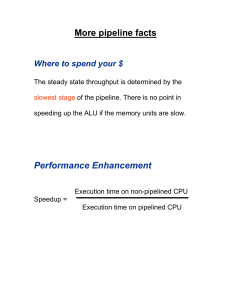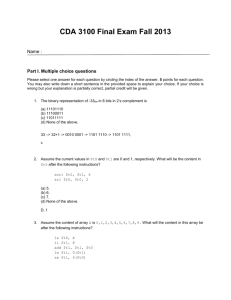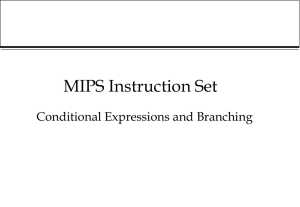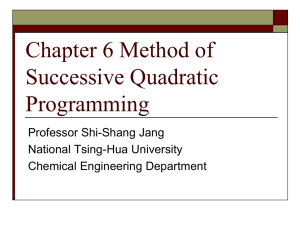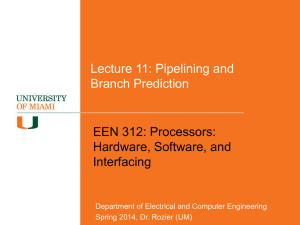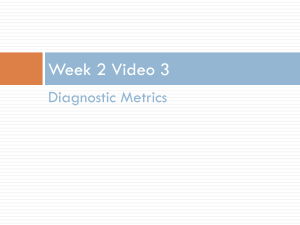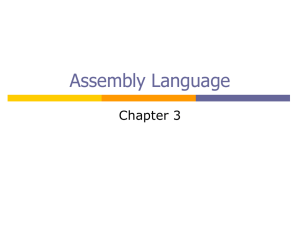Branch Prediction
advertisement
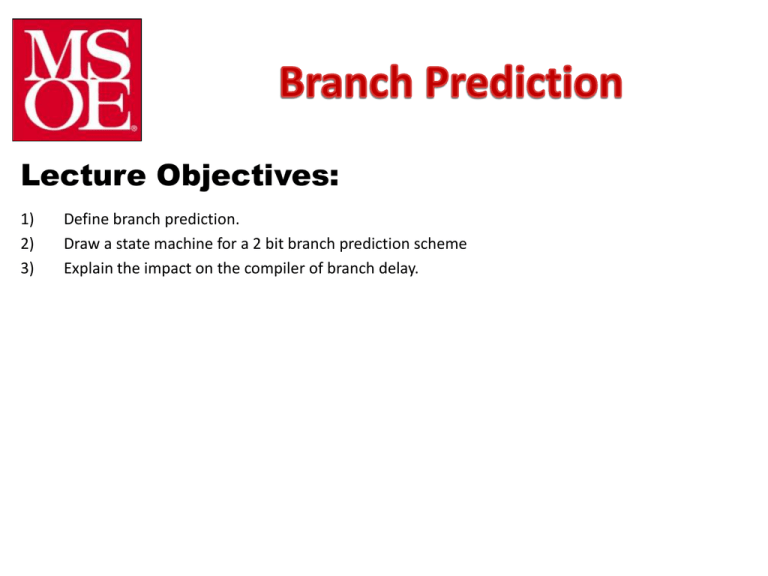
Lecture Objectives: 1) 2) 3) Define branch prediction. Draw a state machine for a 2 bit branch prediction scheme Explain the impact on the compiler of branch delay. Control Hazards • Consider: add beq $t1, $zero, $zero # t1=0 $t1, $zero, Ifequal Notequal: addi $v0, $zero, 4 Ifequal: addi $v0, $zero, 17 • Branch determines flow of control – Fetching next instruction depends on branch outcome Chapter 4 — The Processor — 2 Stall on Branch • Wait until branch outcome determined before fetching next instruction – Pipeline can’t determine next instruction until MEM stage of beq • Still working on ID stage of beq when IF should begin! add $t1, $zero, $zero beq $t1, $zero, Ifequal addi $v0, $zero, 4 #Notequal addi $v0, $zero, 17 #Ifequal Chapter 4 — The Processor — 3 Next instr determined here Deciding earlier helps a little… • Extra hardware can be designed to test registers and update the PC in the ID stage – Then IF of next inst can be done one step earlier • Still have a 1-cycle stall, however add $t1, $zero, $zero beq $t1, $zero, Ifequal addi $v0, $zero, 4 #Notequal addi $v0, $zero, 17 #Ifequal Next instr determined here with extra hardware Chapter 4 — The Processor — 4 Performance penalty of stalling on branch: 17% of instructions executed in the SPECint2006 benchmark are branch instructions – If we always stalled for 1 clock cycle on a branch, what performance penalty would we have? CS2710 Computer Organization 5 Branch Prediction – A method of resolving branch hazards that assumes a given outcome for the branch and proceeds from that assumption rather than waiting to ascertain the actual outcome CS2710 Computer Organization 6 1-bit Dynamic Branch Prediction – One possibility is to have each branch instruction reserve a bit that retains the “history” of the last decision • 0: branch not taken • 1: branch taken – To execute a branch • Check history bit, expect the same outcome • Start fetching from fall-through (next instruction) or branch target • If wrong, flush pipeline and flip prediction bit add $t1, $zero, $zero Next actual instr determined here beq $t1, $zero, Ifequal addi $v0, $zero, 4 #Notequal CS2710 Computer Organization 7 Problems with 1-bit Dynamic Branch Prediction – Consider a loop that branches 9 times in a row, then is not taken once (end of loop condition is met) • Branch taken 9 times, not taken 1 time – At steady state • The first branch decision will be incorrect (from previous execution) • The final branch decision will be incorrect • Thus, the prediction accuracy would only be 80% CS2710 Computer Organization 8 2-Bit Predictor • Only change prediction on two successive mispredictions Chapter 4 — The Processor — 9 Loops and Static Branch Prediction • Consider the following loop of code – Which branch might we reliably predict? .text main: li $t0, 100 loop: addi $t0, $t0, -1 add $t0, $t0, $zero bnez $t0, loop #other instructions follow here… CS2710 Computer Organization 10 Example 2: Assembly while-loop .text main: li $t0, 10 Which branch is more probable? loop: beqz $t0, exitLoop addi $t0, $t0, -1 add $t0, $t0, $zero j loop exitLoop: # Goto main j main CS2710 Computer Organization 11 Static prediction based on code analysis (done by compiler) • Assume all branches to a previous address are always taken • Assume all branches to a subsequent address are not taken CS2710 Computer Organization 12 Dynamic Versus static branch prediction • Static branch prediction – Based on typical branch behavior – Example: loop and if-statement branches • Predict backward branches taken • Predict forward branches not taken • Dynamic branch prediction – Hardware measures actual branch behavior • e.g., record recent history of each branch – Assume future behavior will continue the trend • When wrong, stall while re-fetching, and update history CS2710 Computer Organization 13 Survey • The branch prediction methods we just discussed were examples of A. Static Branch Prediction B. Dynamic Branch Prediction C. I haven’t a clue CS2710 Computer Organization 14 MIPS approach: delayed branching • Always assume “branch not taken”. – This means the instruction immediately following the branch instruction will always begin to execute – The actual decision to branch will/will not be taken until after that instruction begins to execute! – Leaves it to the compiler to insert a “useful” instruction right after the branch that would have needed to execute whether or not the branch was taken add $t1, $zero, $zero beq $t1, $zero, Ifequal #next inst after beq!! Chapter 4 — The Processor — 15 Next actual instr determined here with extra hardware Delayed branching example before after #previous instructions add $s1, $s2, $s3 beq $s2, $zero, Ifequal # no-branch instructions Ifequal: # branch instructions #previous instructions beq $s2, $zero, Ifequal add $s1, $s2, $s3 # no-branch instructions + Ifequal: # branch instructions •MIPS always assumes “branch not taken”, so the pipeline will automatically begin executing the next instruction following the beq. •The actual branch will be delayed until AFTER the next instruction executes •The compiler must help out by inserting a “useful” instruction after the beq to execute while the branch decision is being made by the processor CS2710 Computer Organization 16 Delayed branching pitfall before not possible #previous instructions add $s2, $s1, $s3 beq $s2, $zero, Ifequal # no-branch instructions Ifequal: # branch instructions #previous instructions beq $s2, $zero, Ifequal add $s2, $s1, $s3 # no-branch instructions + Ifequal: # branch instructions •In this case, the beq instruction depends on $s2 being up-to-date before the branching decision is made •If the compiler moves the add instruction until after beq, then $s2 will be updated too late – beq would use a “stale” value of $s2!! •The compiler in this case would have to search for a different instruction that it could insert after the beq •If no such instruction can be found (which is rare), the pipeline will stall CS2710 Computer Organization 17
